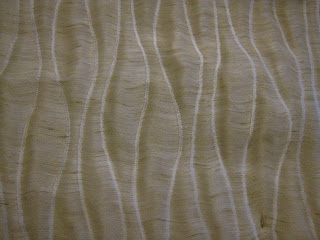Okay, well, in this business, mistakes don't happen. The truth is, one MAKES mistakes. That is, I should say, I make mistakes. There, I said it. Occasionally I make mistakes. Okay, well, really, I often make mistakes. No, really, not all that often. But sometimes.
So, see this beautiful silk print?
You got it- I made a mistake. After joining the widths for 3 valances and 3 bottom facings, I made a mistake cutting the bottom shape. I realized it almost immediately, so the damage was in just the outermost pieced section, of 6 layers. The damage, however, was done, and my stomach did a little flip-flop. Uh-oh. This one's gonna cost me, I feared.
Now, it takes some steel nerves sometimes to cut into customers' fabrics. Sometimes you're cutting up many thousands of dollars' worth of fabric. One wrong cut and a dye lot that's no longer available, and you're buying a new bolt of some $120/yd-wholesale fabric. ouch.
So we workrooms tend to be very careful.
We also draw on all our experience to not only plan well, but also to find ways to rectify mistakes when they happen.
When I was growing up, until I was about 35, I sewed most of my own clothes. (That's when I started sewing for a living and sewing for fun kind of ended). If I made a mistake on a project, I had to improvise to find a solution because there simply wasn't money to go buy more fabric. This silk fabric retails for $50/yd, not horrible, but still, I was going to find a way around the mistake.
When I was about 12, I made a yellow dress with a square neckline and short sleeves which I piped in navy blue. (lovely, eh?) I set the sleeves in backwards. So I took them out, and put them back in, backwards again. So I took them out, and put them back in, backwards again. That's not a typo, I really did it wrong 3 times. Finally I put them in correctly. Luckily that time I didn't ruin any fabric.
But plenty of times I did cut incorrectly, and boy, I learned to find ways to "make it work" (in the words of Tim Gunn, I hope everybody reading this watches Project Runway). Those youthful decades of developing and honing problem-solving skills have served me well as a window treatment fabricator! I can almost always find a way to work around mistakes, as well as fabric flaws and short fabric, using the available yardage.
I also was always trying to find ways to make my garment with less yardage than the pattern called for. I was motivated by a desire either to spend less, or to have some leftover which I always believed I'd use for something later one.
In the case of the silk, above, I found that I had JUST ENOUGH left over to re-cut the section that I cut wrong. The reason I had leftover was because- by the book, the customer sent exactly enough fabric to make the job, but when I was laying it out I thought of a way to combine the cuts to use less, and I had yardage to spare. Thought it wasn't necessary to save fabric, I did it out of habits formed 30-40 years ago. It was a little tricky finding a way to match the pattern, but it worked out. So I have just finished re-cutting and re-piecing the damaged sections. (Which is why it's a beautiful Sunday morning and I'm at the studio).
But to look at the bright side- in spite of the mistake I still have some lovely scraps of this printed silk that are going to look great in some project. Someday. I swear. Before I'm 80.


































